MLS commissioner Don Garber Q&A: On 20th season, expansion, more

NEW YORK — MLS finishes its 20th season this Sunday when Columbus hosts Portland in the MLS Cup final (4 p.m. ET, ESPN, Unimás), and on Tuesday MLS commissioner Don Garber sat down one-on-one with SI.com for a far-ranging and candid discussion on MLS and American soccer.
Some of the topics discussed included: The future of more MLS teams owning professional women’s teams; league scheduling; experiments in video technology; MLS expansion plans; why the U.S. has yet to produce a male global superstar; a potential increase in Targeted Allocation Money; February’s CCL showdown between MLS and Mexican teams; the U.S. national team’s poor performance in 2015; the FIFA scandal; whether he believes Qatar will end up hosting World Cup 2022; and how MLS can have a salary budget of $4.2 million per team in 2019 and still hope to be one of the world’s top leagues by 2022.
Our conversation was edited for length and clarity.
SI: We’re nearing the end of 2015. People like to take stock at the end of the year. In broad strokes, what were the big things that went well for MLS this year? What do you wish had gone better?
Garber: In my mind there’s no doubt that our 20th season was the best season in our 20 years. It started with the finalization of our collective bargaining agreement, which seems like so long ago. But those were difficult discussions that led to what I think is a great partnership between management and our players. We had a preseason with the excitement of the build-up of our two new teams in Orlando and New York and the signing of Kaká and David Villa and all the drama around Frank Lampard and the idea maybe Steven Gerrard would come to MLS. It really mounted this massive groundswell of preseason buzz that arguably was the most we’ve ever had.
We launched our three television deals, and I think those are landmark partnerships for us, and we embarked on our first international television deals, particularly one in England where we have our games on live on Sky Sports. And we shouldn’t diminish the importance of an eight-year deal at $90 million plus a year [shared with U.S. Soccer] with Fox Sports, ESPN and Univision, and our deals in Canada. We have destination programming that I think will set us up for the future. But it all started here in 2015.
There was a lot of drama around San Jose moving to Houston [in 2006] because we couldn’t get a stadium done. And here we are nine years later starting play in Avaya Stadium, which is a terrific building, and they’ve sold out almost every game. It’s solidified our view that stadiums really can help teams get deeply connected in their community.
We had a summer signing window which was special, bringing in Giovani Dos Santos and Andrea Pirlo and Steven Gerrard to our shores. But I also spend a lot of time thinking about the fact that GyasiZardes had more caps for any first-year U.S. player than ever before, surpassing Claudio Reyna. We had one game with Columbus and Dallas where the majority of the players were homegrown players. So while we have been able to bring in some world-class players to create a lot of interest and appeal here and abroad, we’re still focused on investing in and providing opportunities for the American player and now the Canadian player. Our Rookie of the Year, CyleLarin, was the No. 1 draft pick overall.
So overall I feel really good about 2015. Disappointments? When we put together our plan for 2015, we’ve checked every box.
GALLERY: MLS Cup champions
MLS Cup Winners Through The Years
1996 — D.C. United
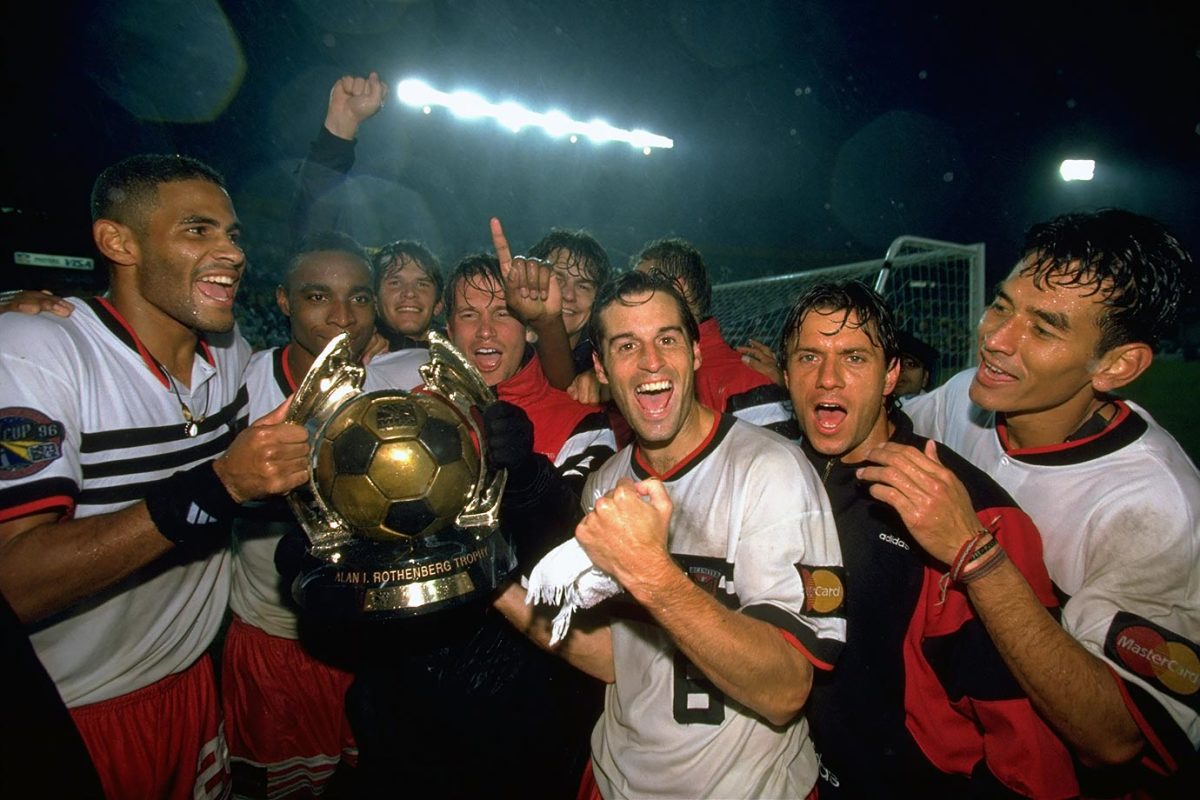
1996 — D.C. United (beat LA Galaxy 3-2 in extra time)
1997 — D.C. United
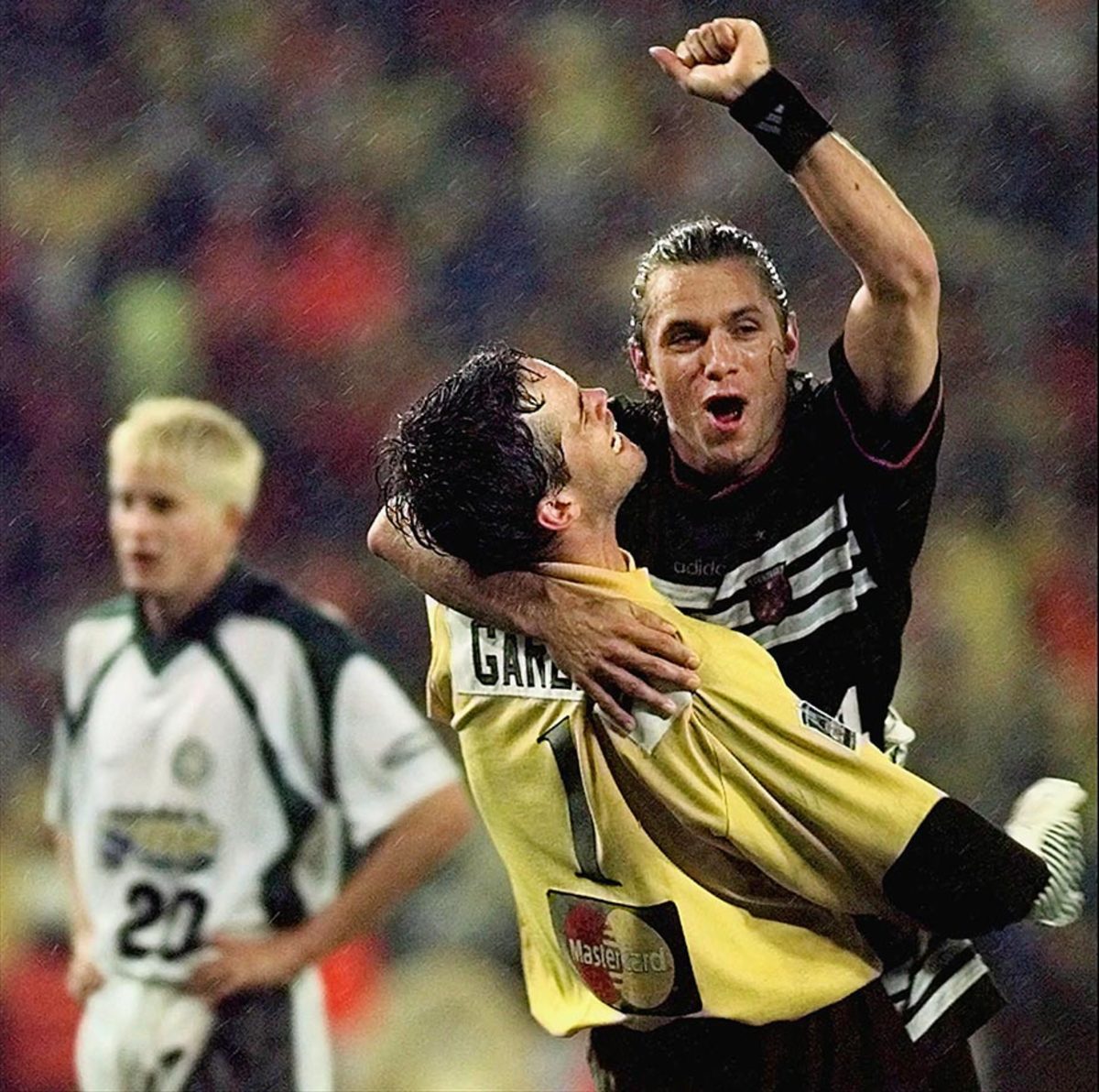
1997 — D.C. United (beat Colorado Rapids 2-1)
1998 — Chicago Fire
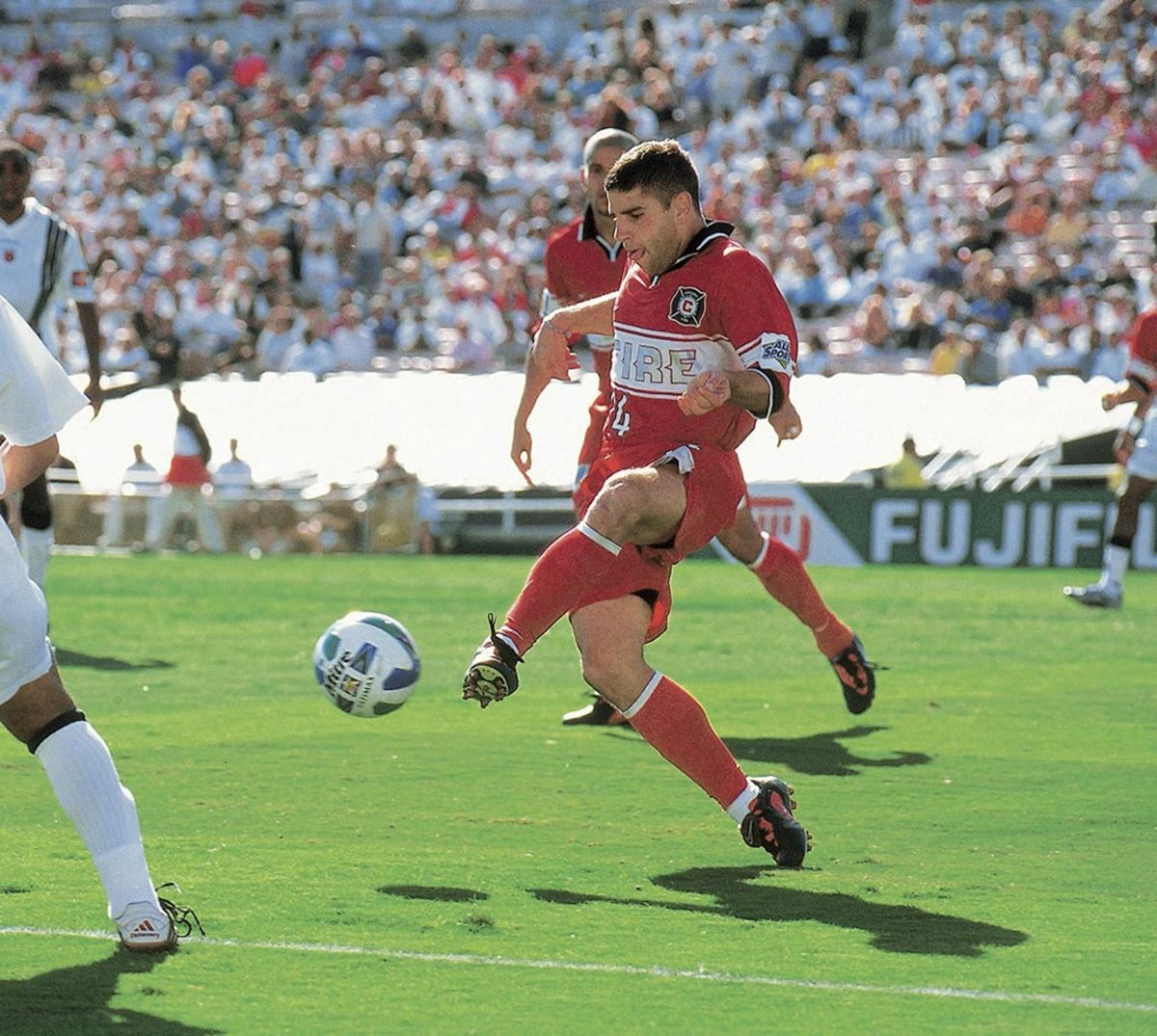
1998 — Chicago Fire (beat D.C. United 2-0)
1999 — D.C. United
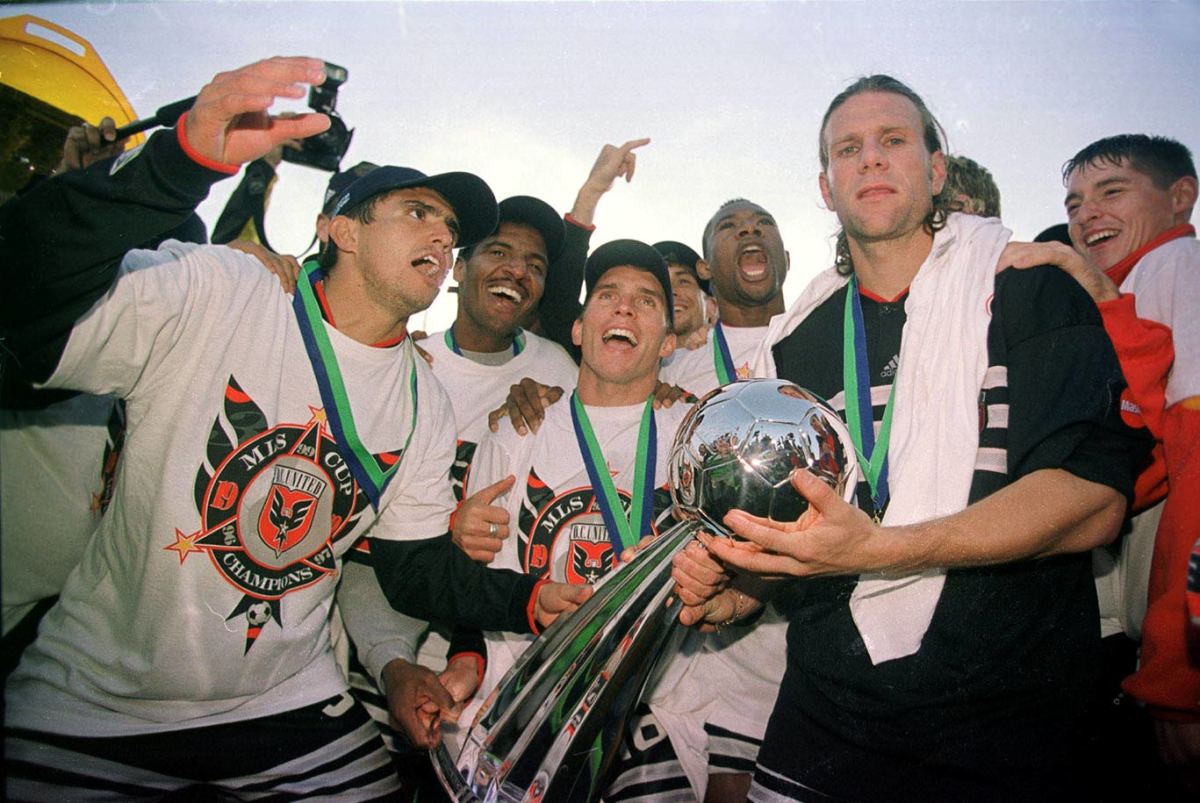
1999 — D.C. United (beat LA Galaxy 2-0)
2000 — Kansas City Wizards
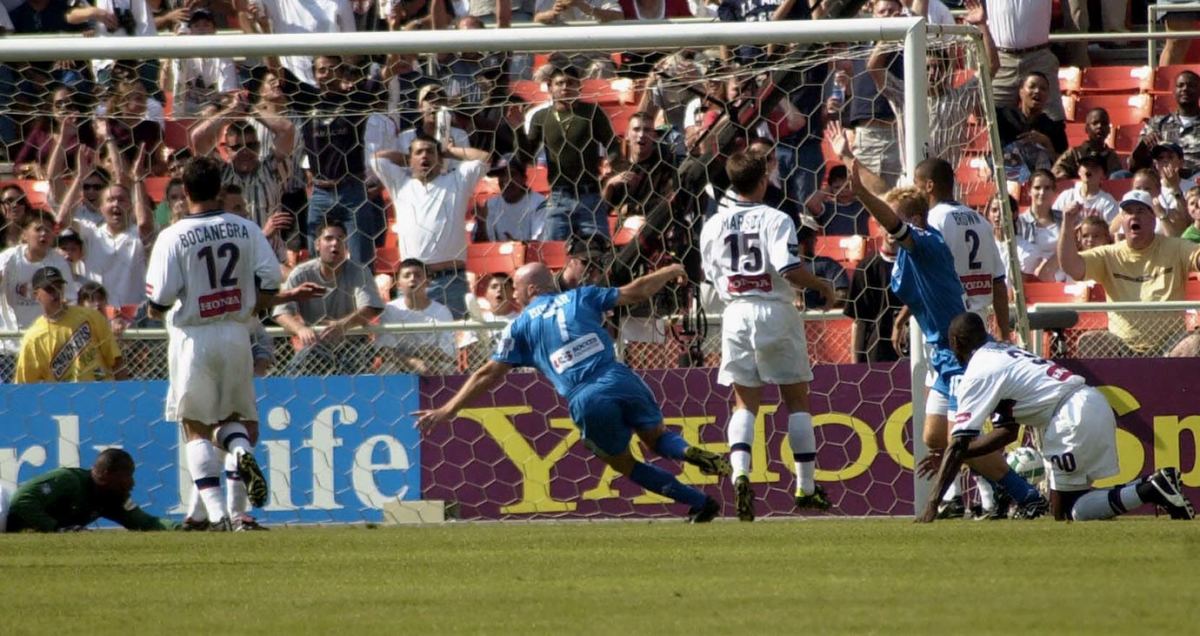
2000 — Kansas City Wizards (beat Chicago Fire 1-0)
2001 — San Jose Earthquakes
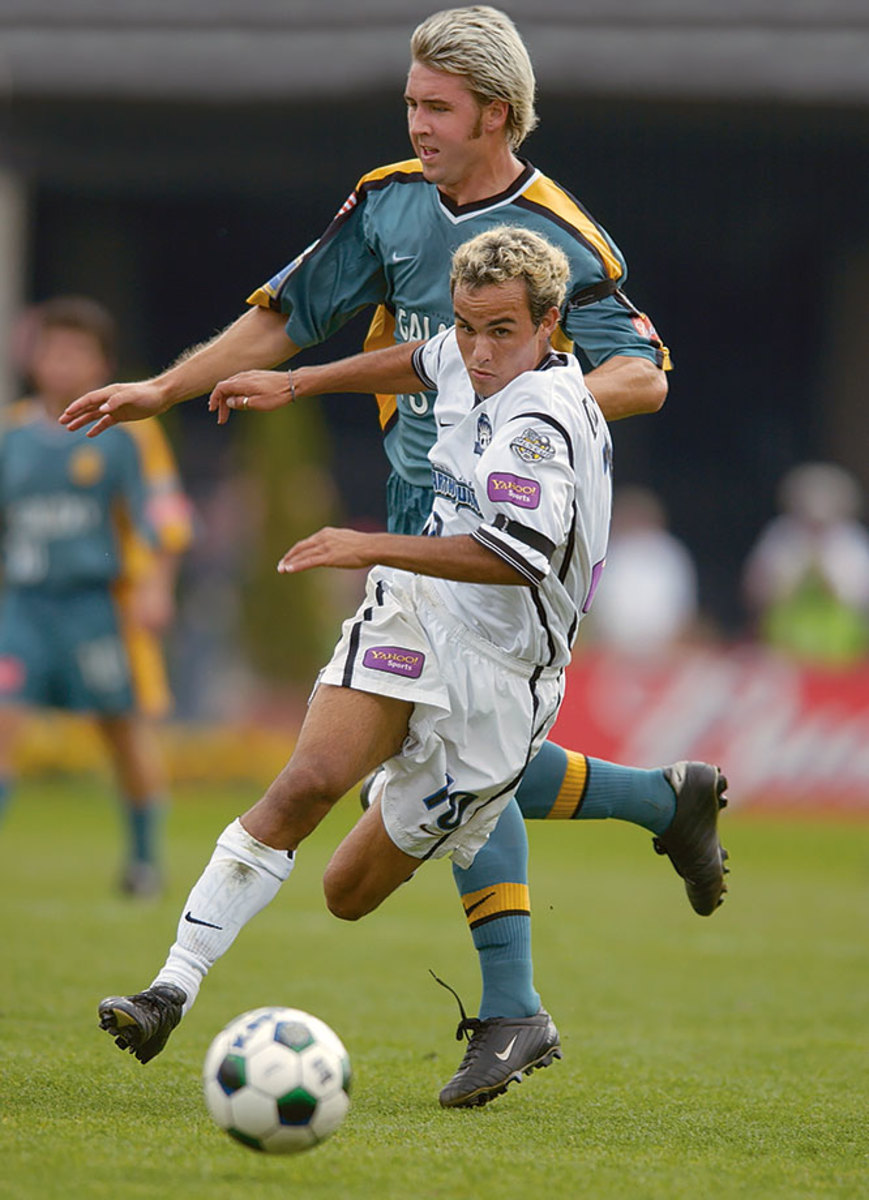
2001 — San Jose Earthquakes (beat LA Galaxy 2-1 in extra time)
2002 — LA Galaxy
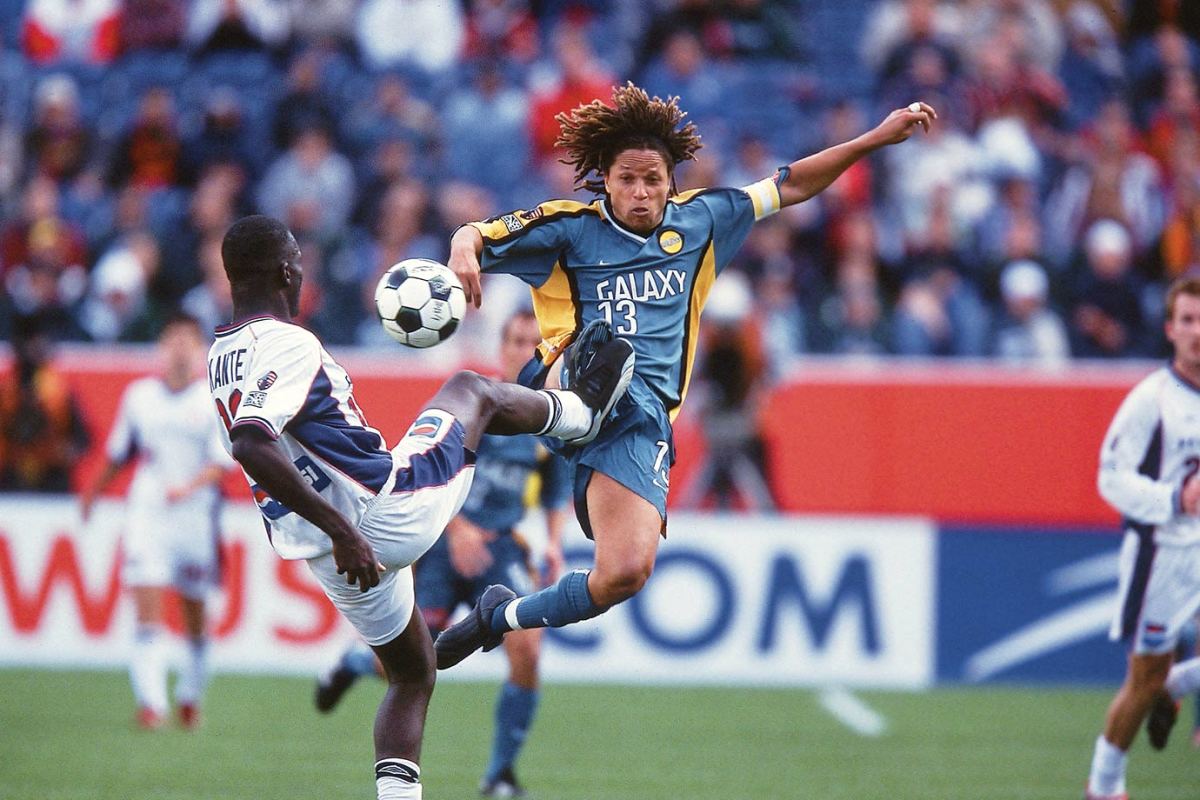
2002 — LA Galaxy (beat New England Revolution 1-0 in extra time)
2003 — San Jose Earthquakes
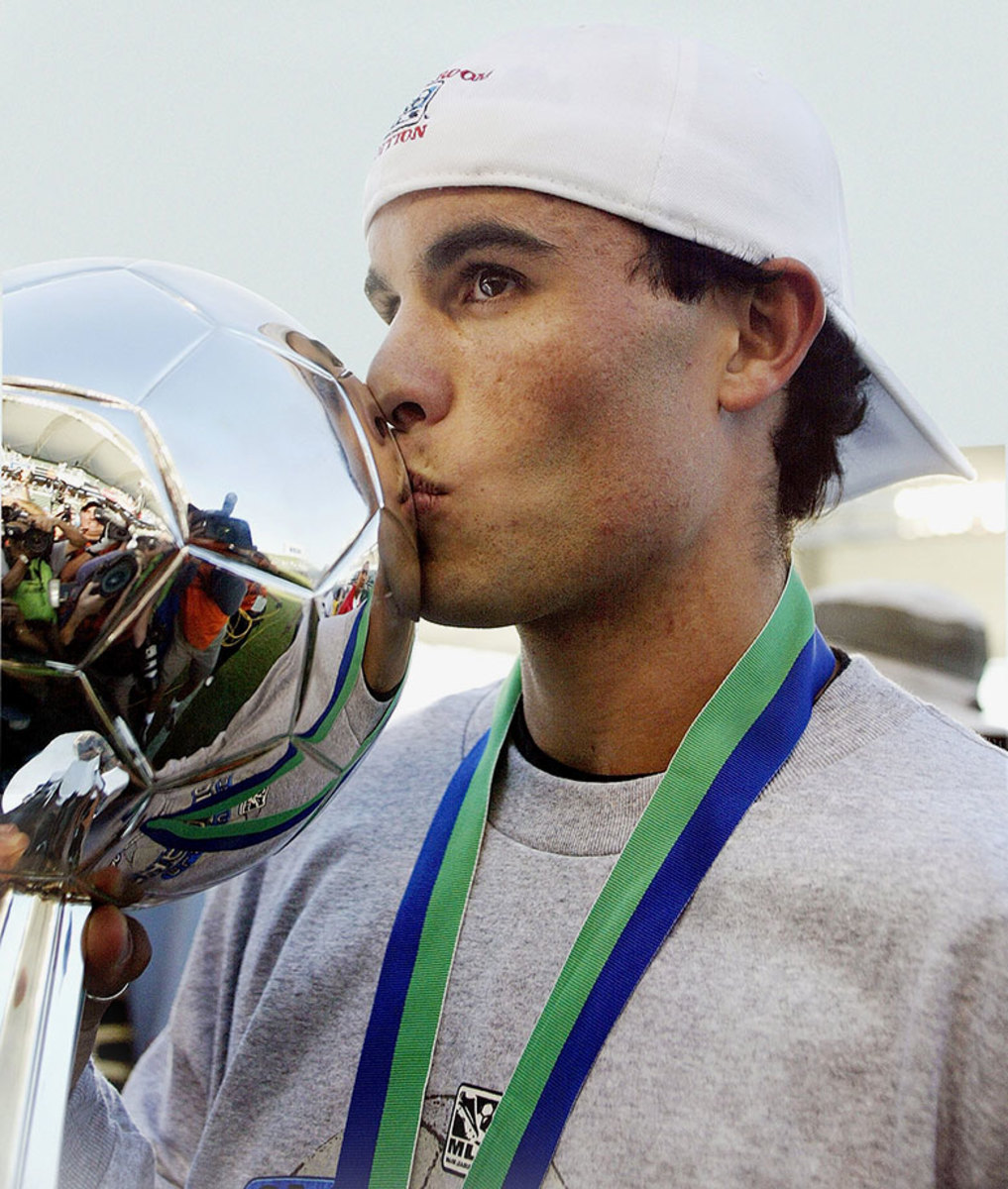
2003 — San Jose Earthquakes (beat Chicago Fire 4-2)
2004 — D.C. United
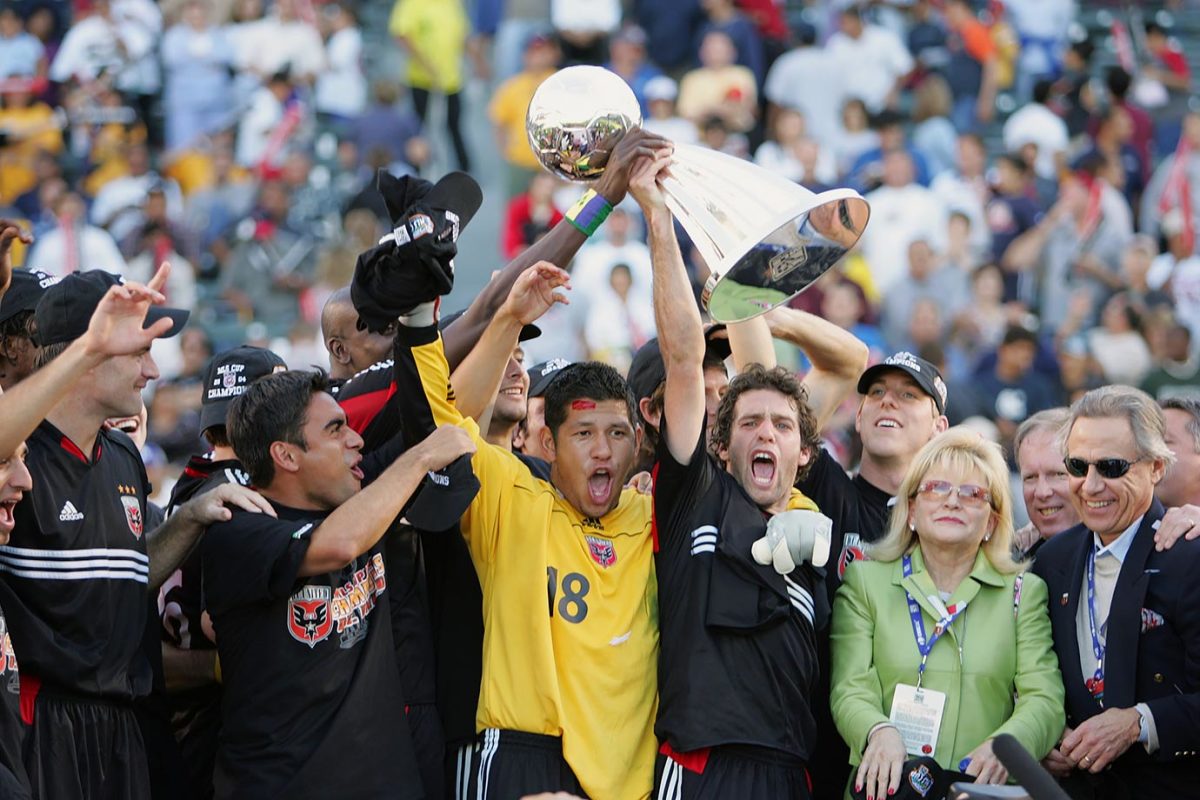
2004 — D.C. United (beat Kansas City Wizards 3-2)
2005 — Los Angeles Galaxy
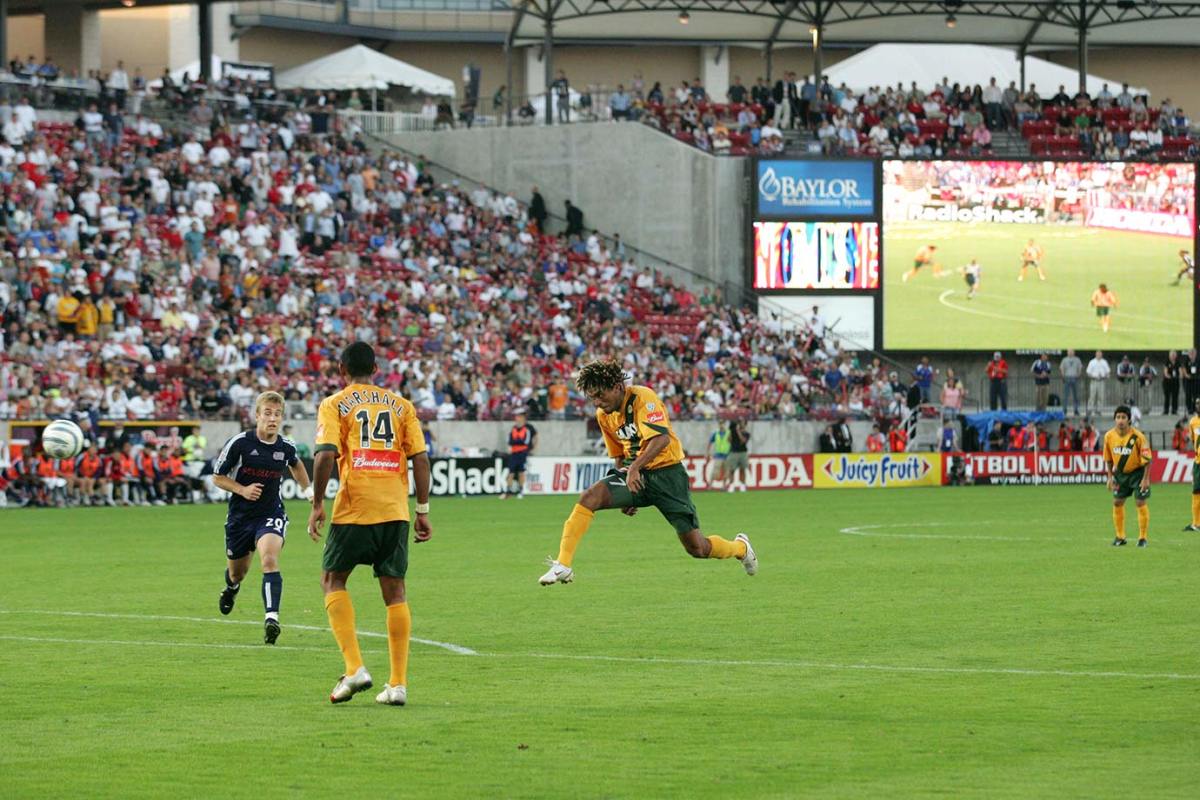
2005 — Los Angeles Galaxy (beat New England Revolution 1-0 in extra time)
2006 — Houston Dynamo
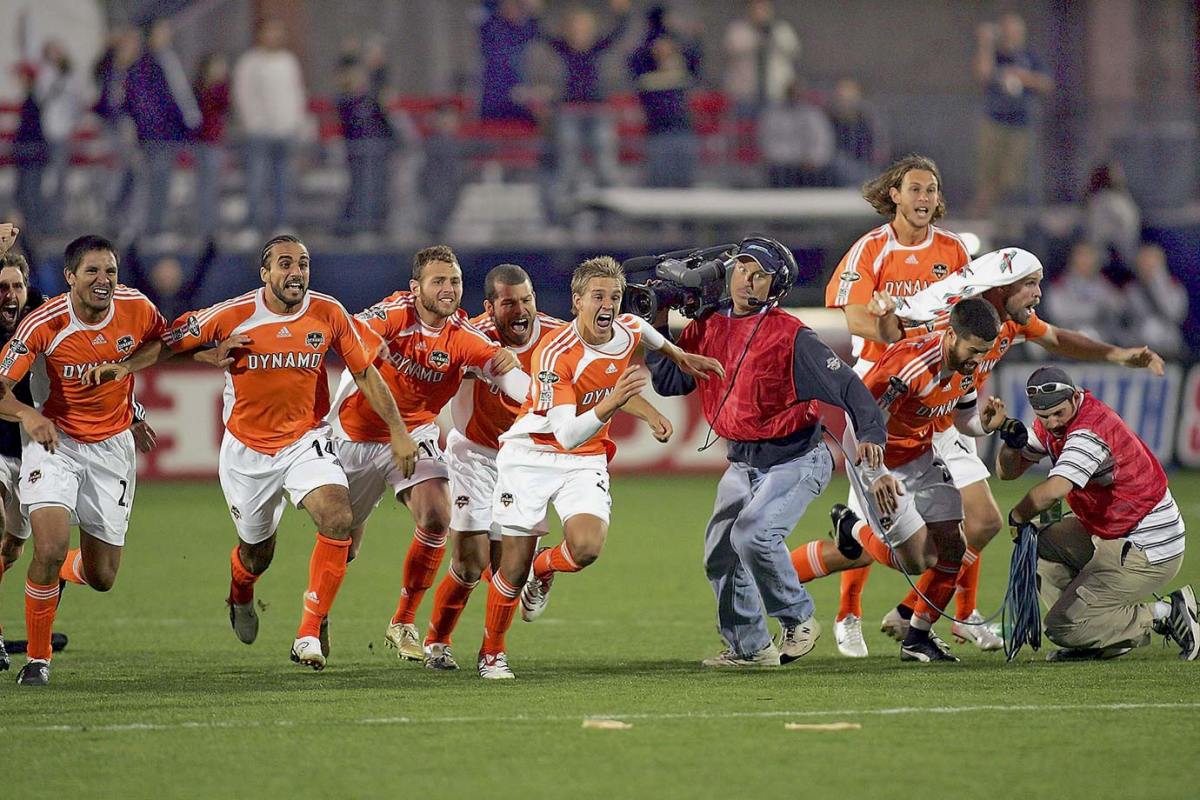
2006 — Houston Dynamo (beat New England Revolution in penalty kicks after 1-1 draw)
2007 — Houston Dynamo
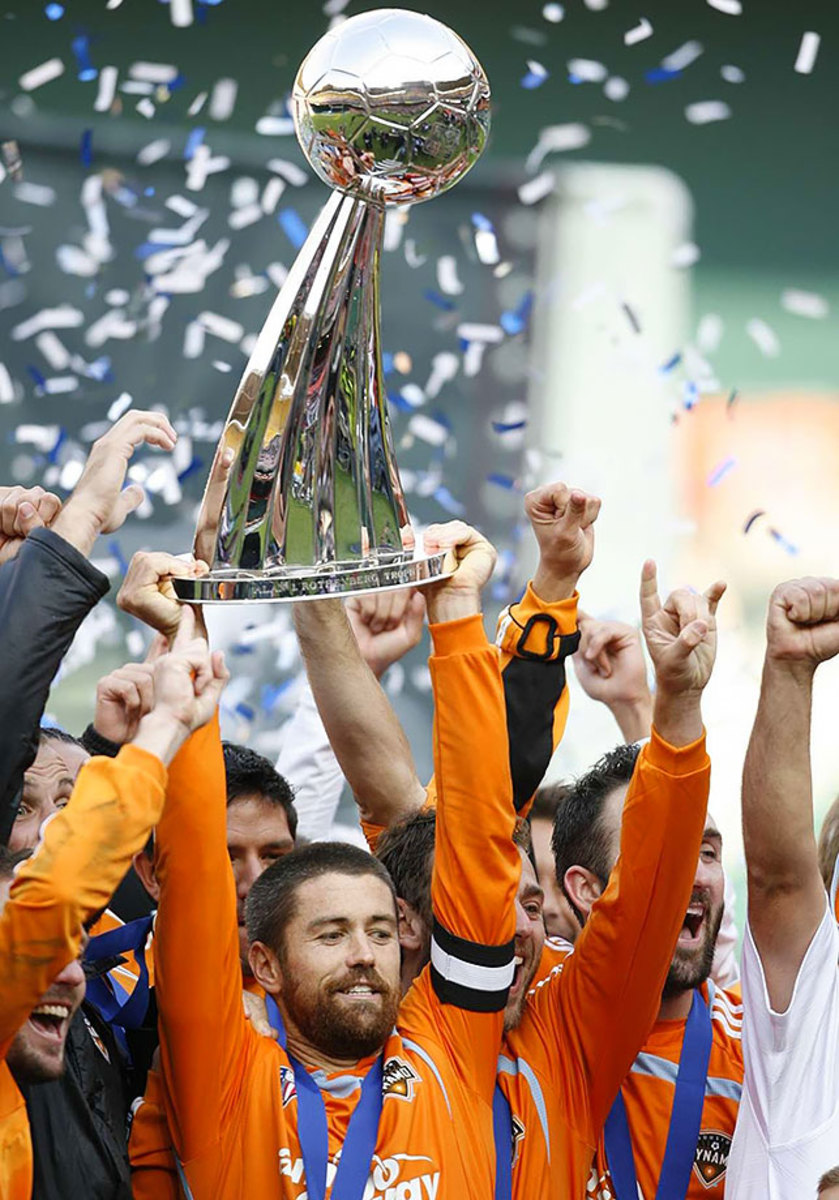
2007 — Houston Dynamo (beat New England Revolution 2-1)
2008 — Columbus Crew
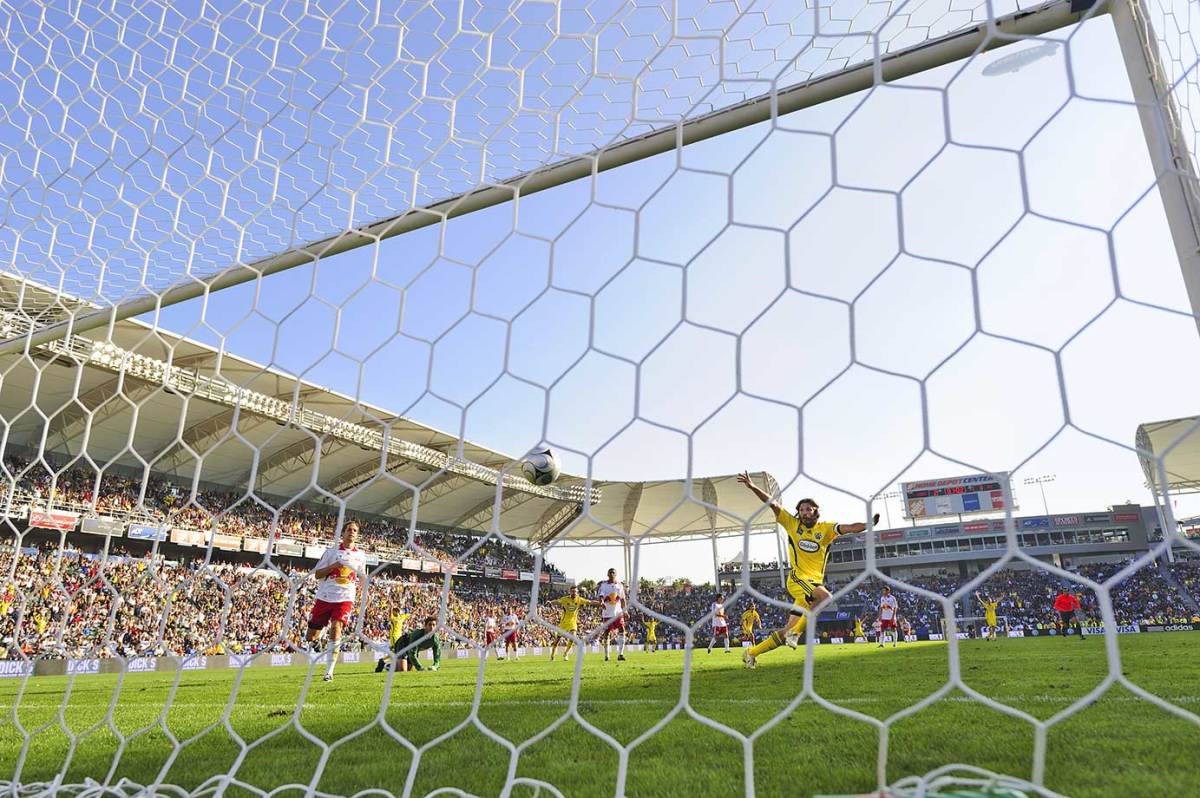
2008 — Columbus Crew (beat New York Red Bulls 3-1)
2009 — Real Salt Lake
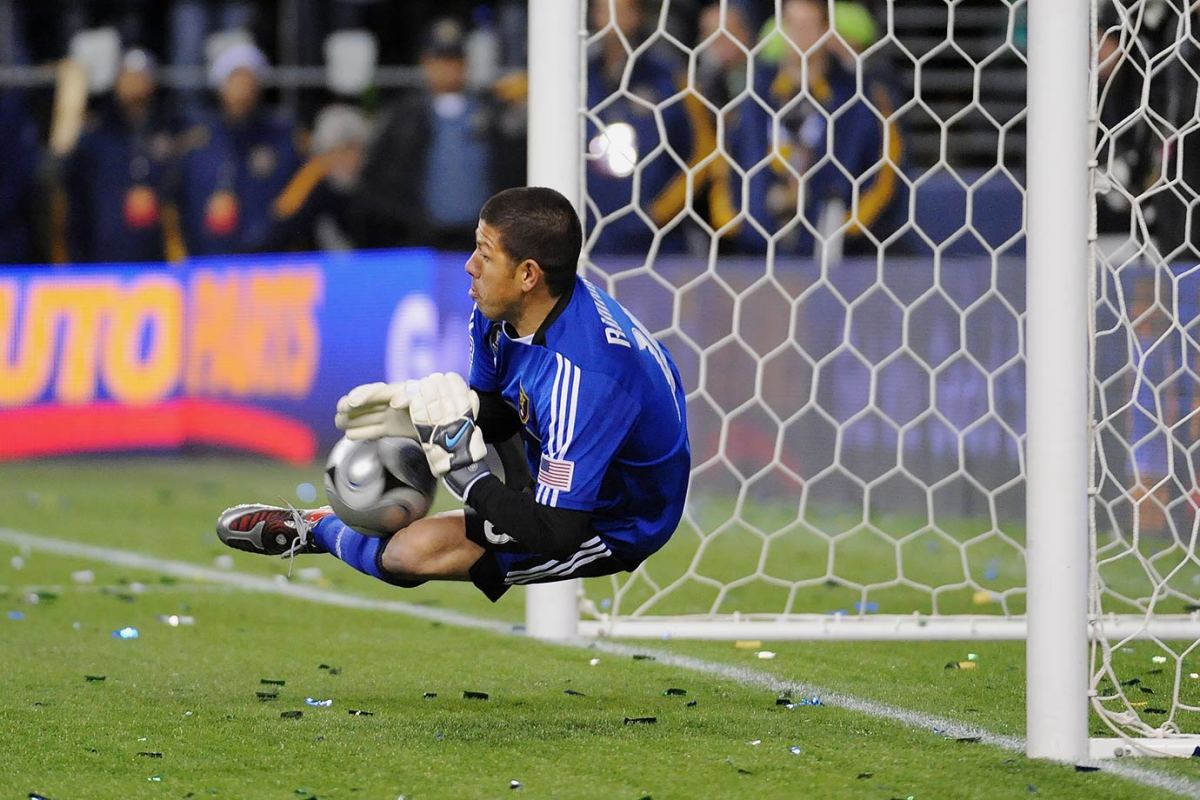
2009 — Real Salt Lake (beat LA Galaxy in penalty kicks after 1-1 draw)
2010 — Colorado Rapids
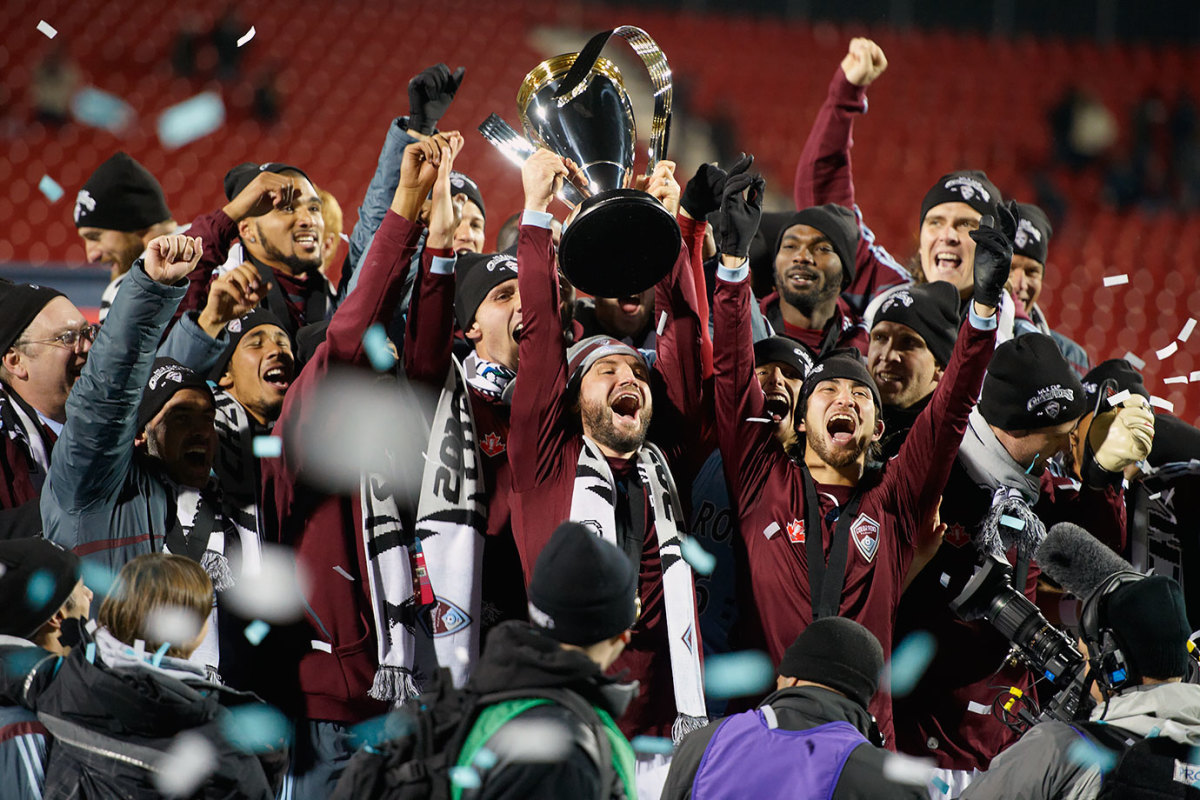
2010 — Colorado Rapids (beat FC Dallas 2-1 in extra time)
2011 — LA Galaxy
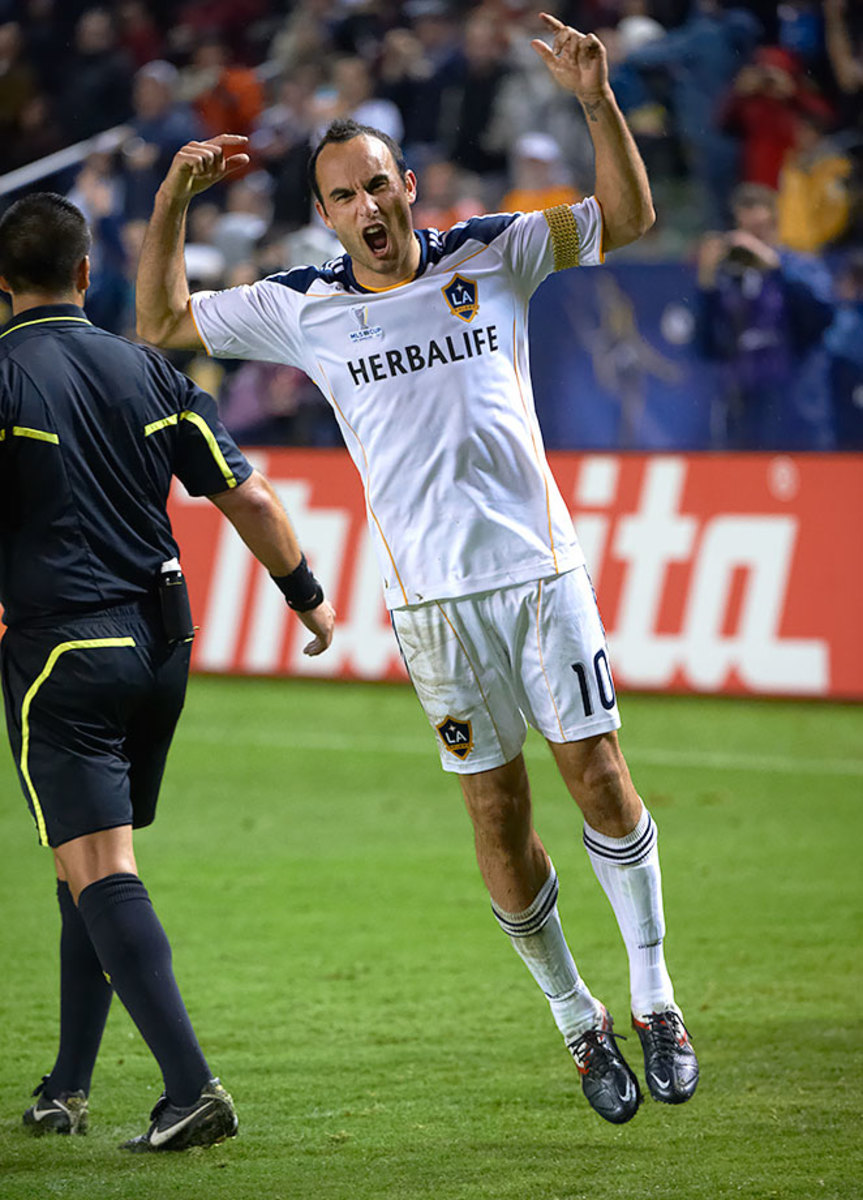
2011 — LA Galaxy (beat Houston Dynamo 1-0)
2012 — LA Galaxy
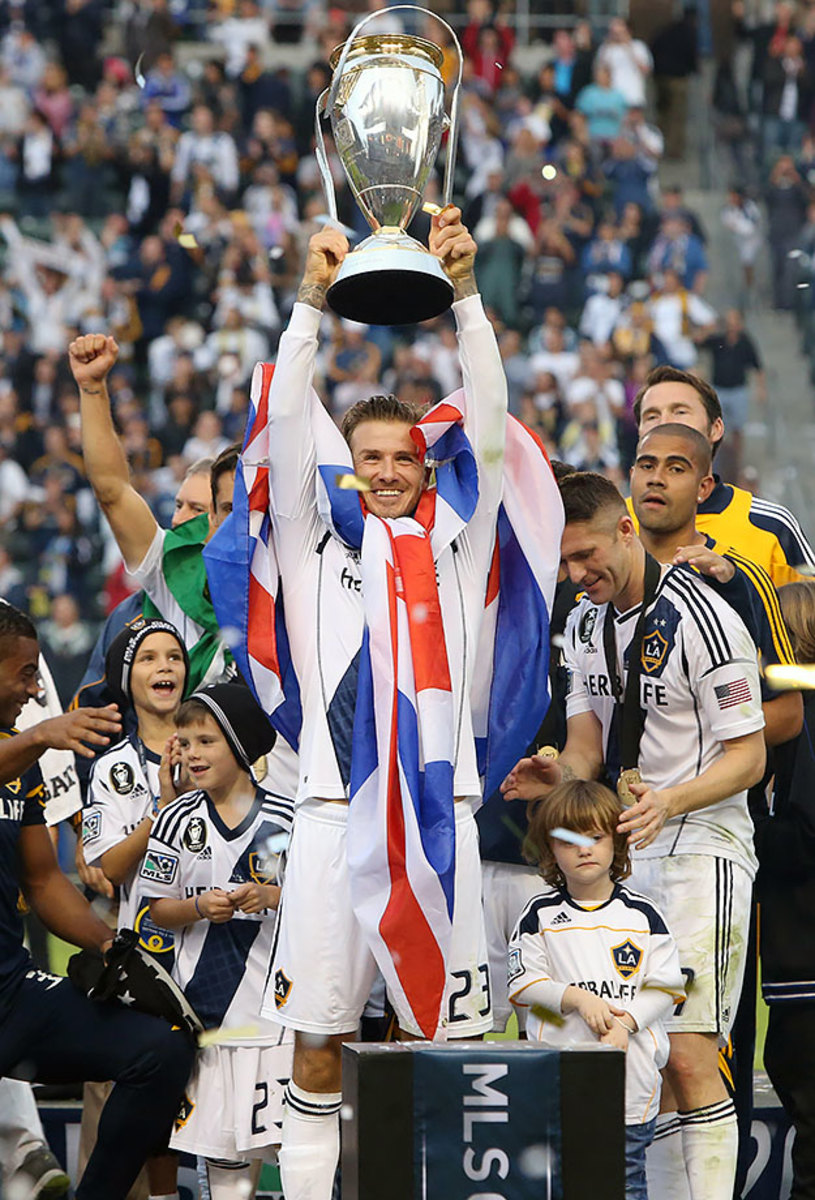
2012 — LA Galaxy (beat Houston Dynamo 3-1)
2013 — Sporting Kansas City
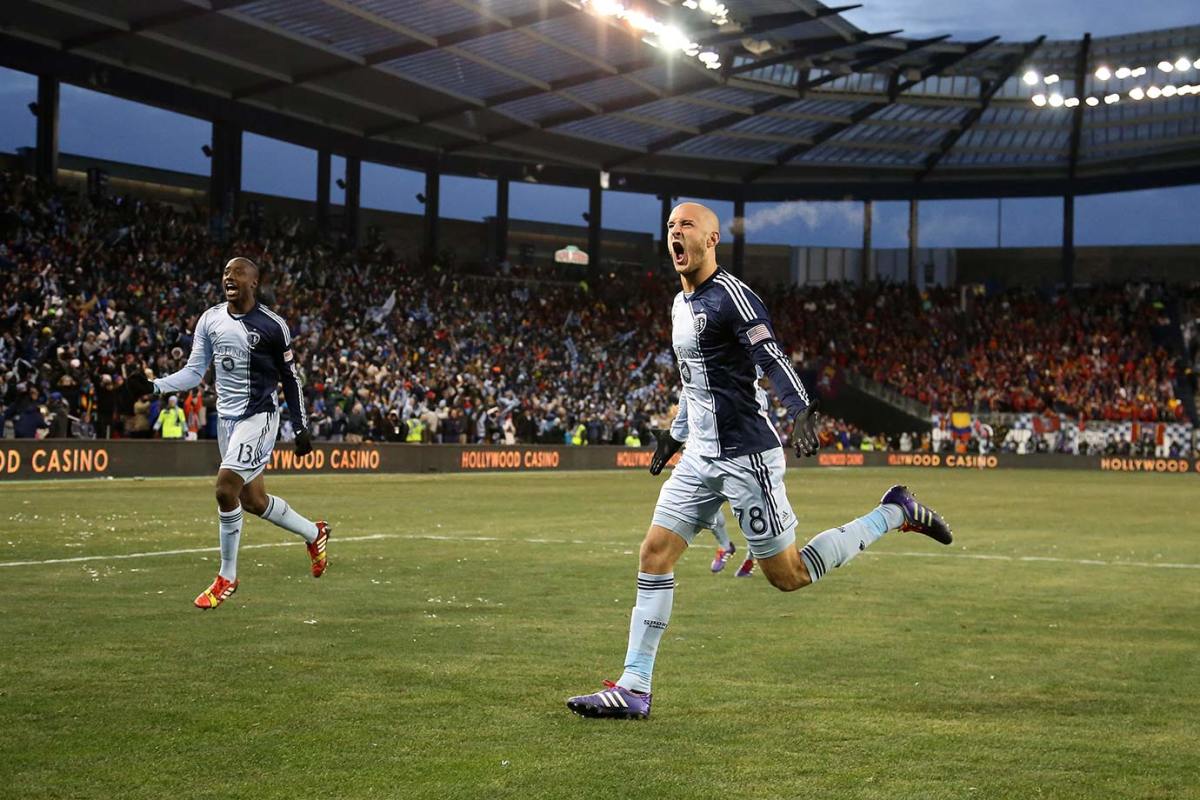
2013 — Sporting Kansas City (beat Real Salt Lake in penalty kicks after 1-1 draw)
2014 — LA Galaxy
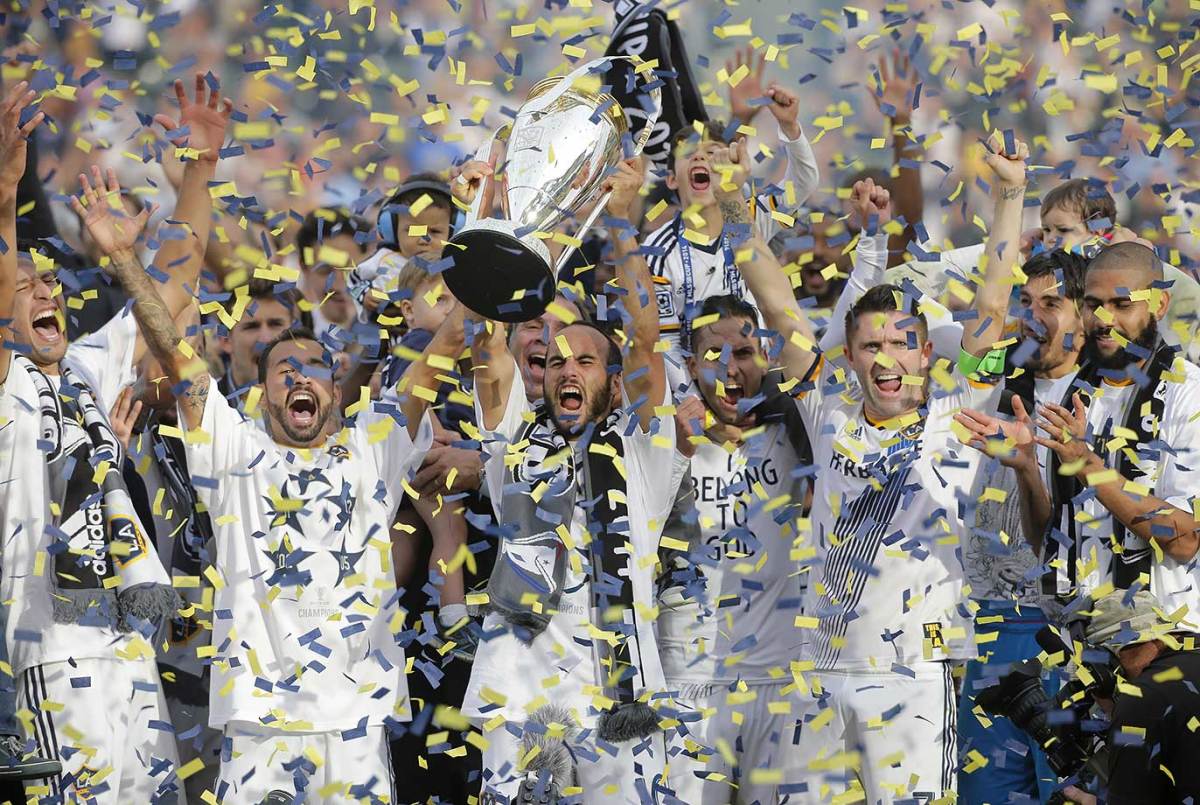
2014 — LA Galaxy (beat New England Revolution 2-1 in extra time)
2015 – Portland Timbers
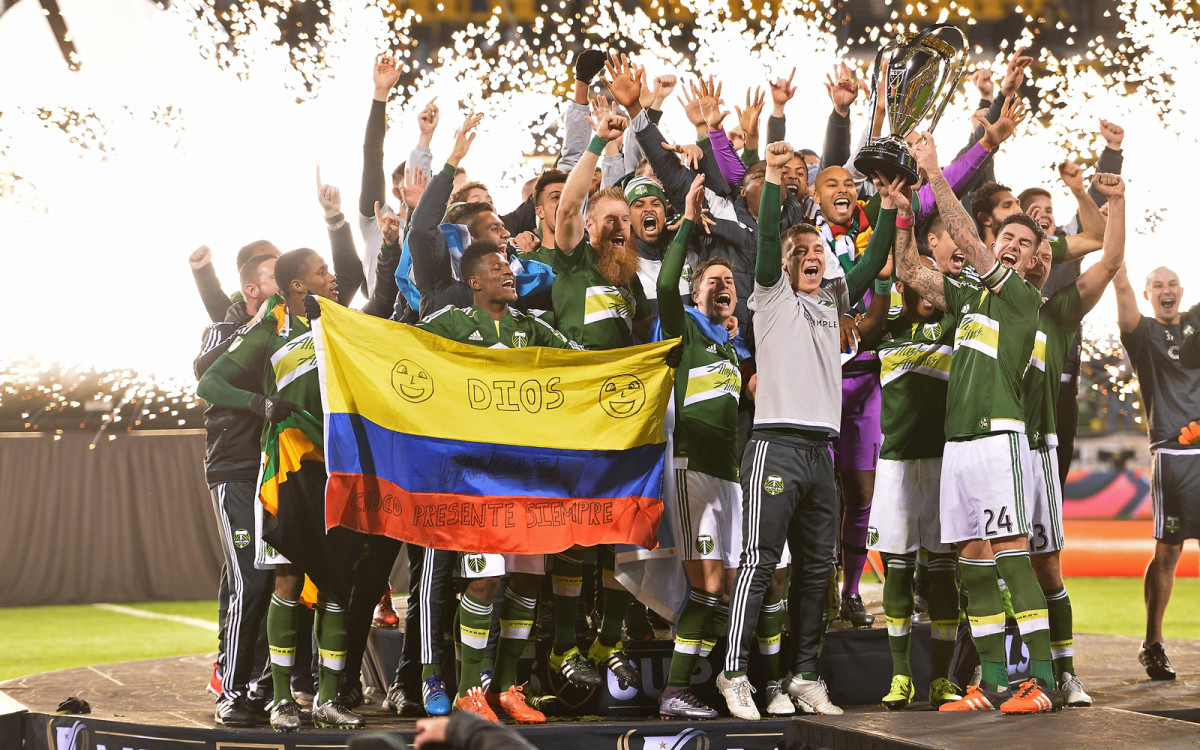
2015 – Portland Timbers (beat Columbus Crew SC 2-1)
2016 – Seattle Sounders
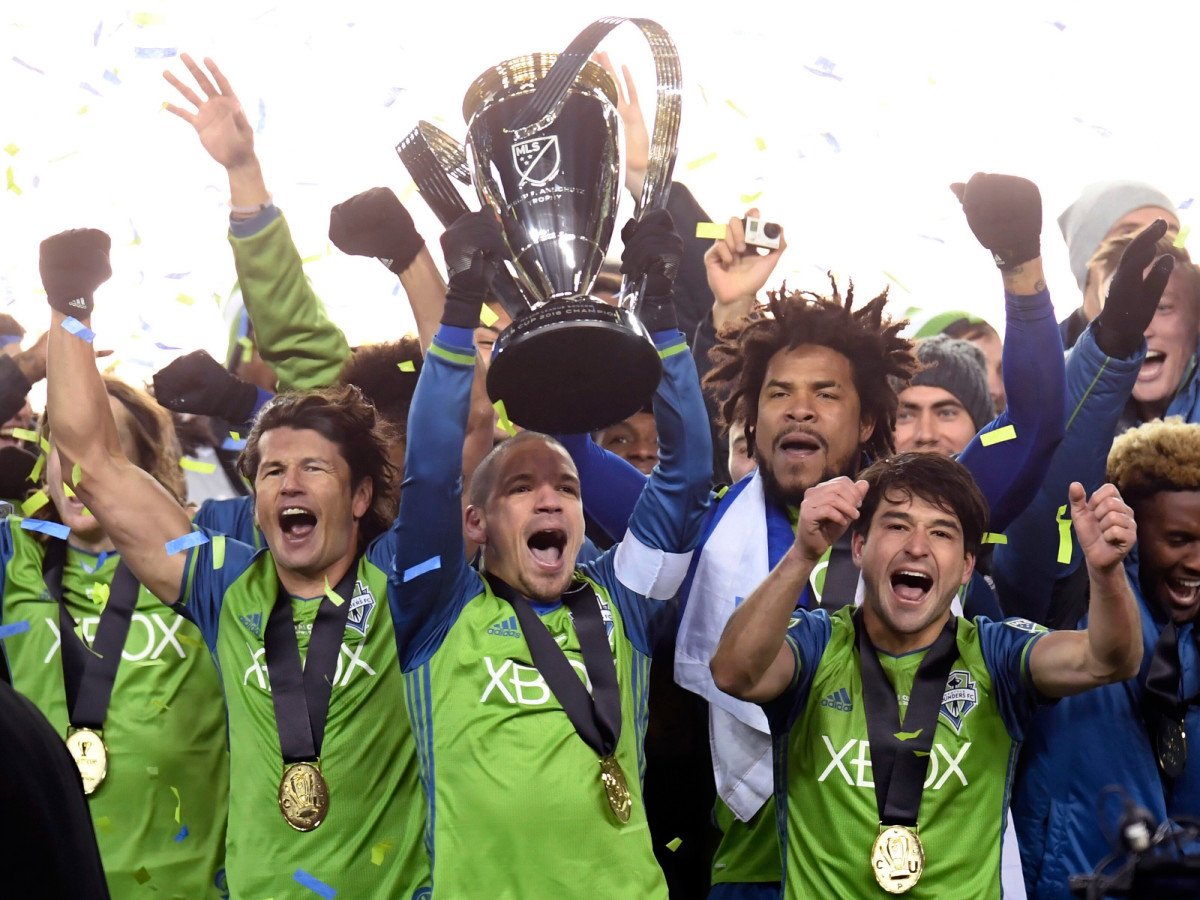
2016 – Seattle Sounders (beat Toronto FC in penalty kicks after 0-0 draw)
2017 – Toronto FC
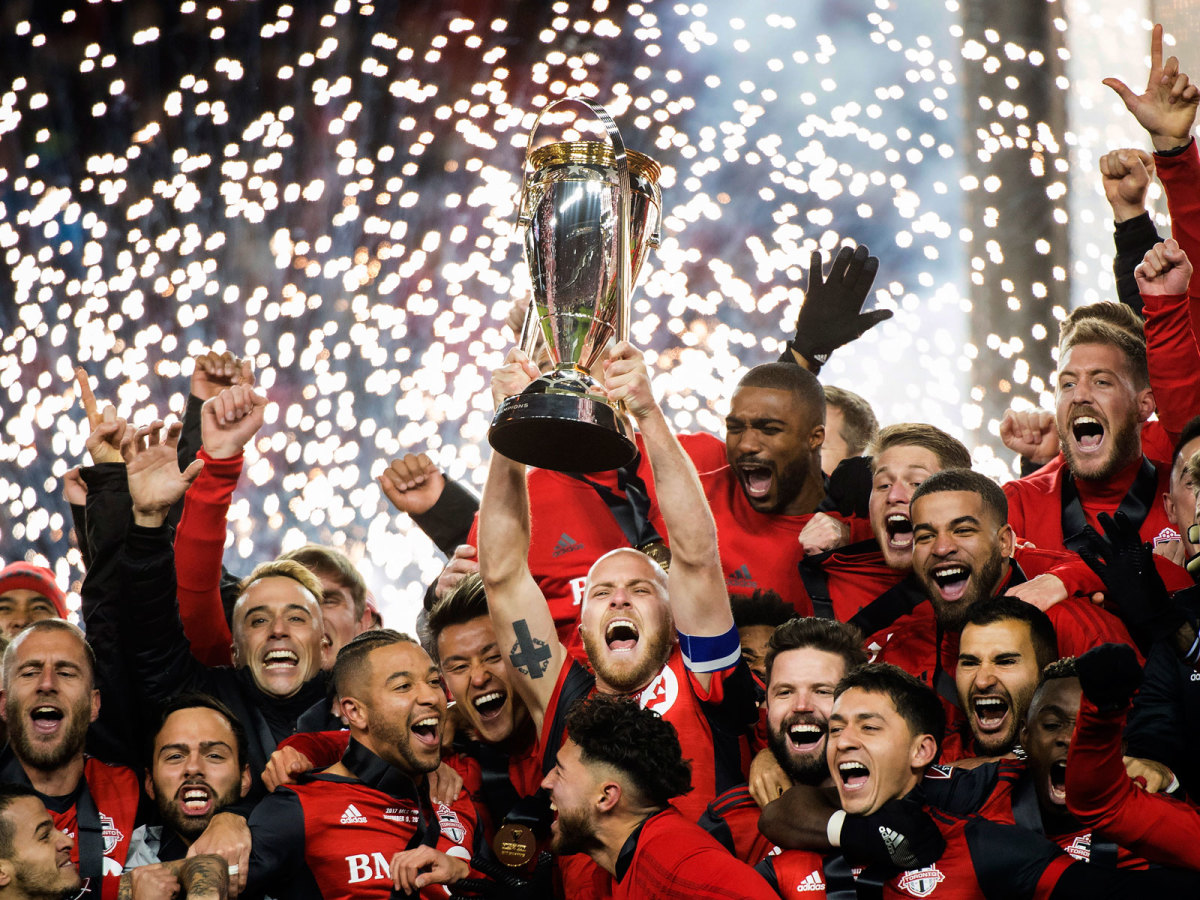
2017 – Toronto FC (beat Seattle Sounders 2-0)
2018 - Atlanta United
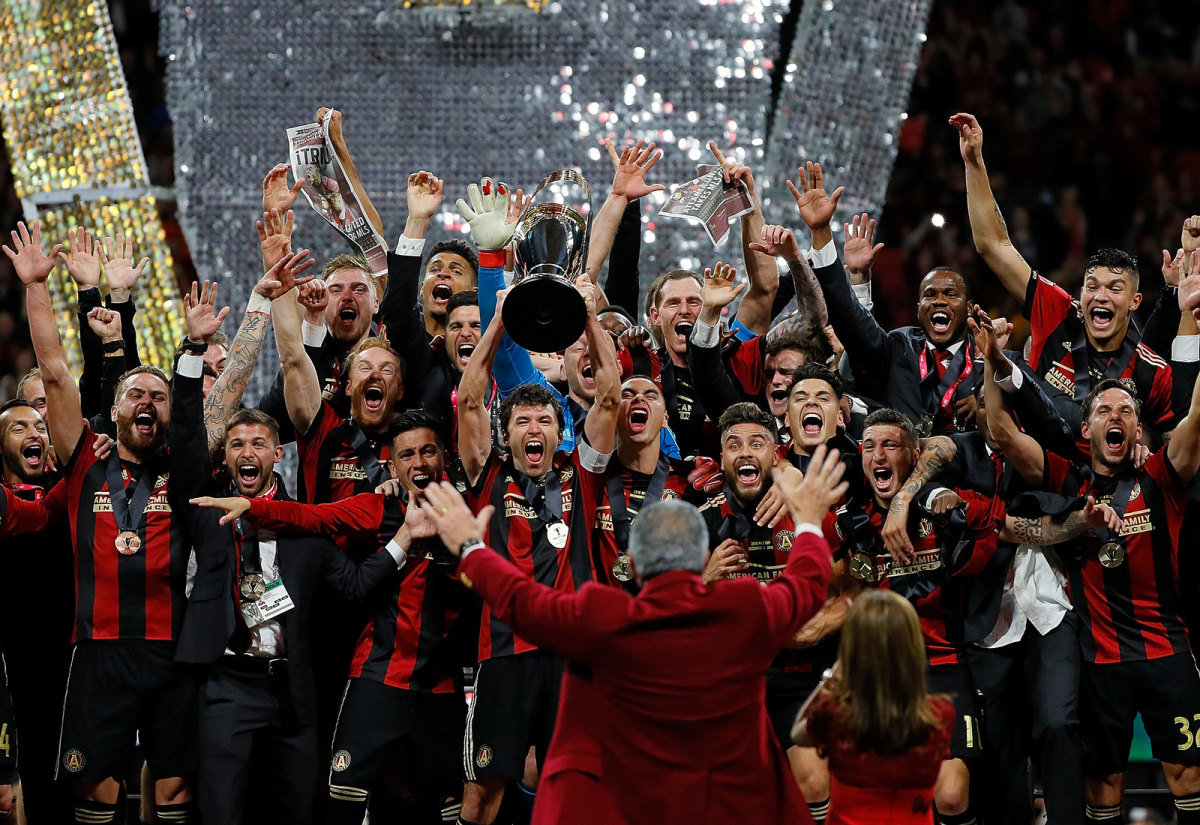
2018 - Atlanta United (beat Portland Timbers 2-0)
SI: I’ll bring up some possibilities in future questions here. As for the TV deal, were you satisfied with the Friday and Sunday national broadcasts? Can we expect something similar next season?
Garber: Yes. This is year one of an eight-year deal. We and our partners are committed to having an exclusive window in prime time on Fridays and Sundays. We’ll continue to look at it to see that it’s best for our fans and ultimately will work to drive TV ratings. But I’m really proud of what we’ve been able to do, and I can’t speak enough about how great our relationships are, particularly nationally with our three partners.
SI: The MLS Cup final is on a Sunday this week. Is there any chance in the future we could see it happen on a different day of the week?
Garber: Yeah, there is a chance. We’ve got this unique challenge. We play almost year-round. We have the shortest offseason of any pro league in the U.S. and Canada. We open up around the start of March Madness and end right in the middle of the core of the NFL season. We’ve got to fit inside that all sorts of international competitions and FIFA dates that continue to impede our ability to have the consistency we want. We are more committed than ever in particular in the Champions League and U.S. Open Cup. That all goes into this enormous funnel which complicates everything. So we have to look at do we have the right schedule for our playoffs and for our cup final that could give us a little bit of exclusive real estate?
SI: So we could see the MLS Cup final on a Tuesday night in the future?
Garber: It’s conceivable that the final could move midweek so we could at least establish our own exclusive window.
SI: You’ve talked in the past about your support for MLS implementing and being a global guinea pig for instant replay, video review, coach challenges and goalline technology. How close are we to seeing that happen in real MLS games?
Garber: I am personally and our owners are fully committed to using technology to make our game better, to train our players better and ensure we have the proper outcomes that the rest of the pro sports league in North America are able to capitalize on and benefit from. It doesn’t make me any less of a soccer person. I think it makes me more of a soccer person. I think the game has changed. Why not use technology to help the game get better? We’ll continue to experiment this year. We’re looking at doing some things in the USL, and we’re investing resources to ensure we get the technology right. We did have a test that we laid out for our player competition committee in the spring, so we are looking at something very special. We’ve not tested it live in an MLS game yet. But it’s conceivable that we could do that in 2016.
SI: At a recent panel, three MLS owners were asked how many teams they thought the league would have in 20 years. Two said 32 teams. One said 40. How would an MLS with 40 teams work?
Garber: Well, as much as I admire and respect the MLS owners on that panel, there is almost no chance there will be 40 teams in MLS in 20 years. I think the real story here is we don’t really know how big MLS will be. We do know that it will be bigger, and we do know it will certainly go past 24 teams. But how many teams over what period of time is a guess by anyone at this point. I think the comment at BlazerCon was fun and provocative, but there has been absolutely no work whatsoever on trying to determine the total number of teams and over what period of time.
SI: Could we ever see an MLS1 and MLS2 with promotion and relegation in-between?
Garber: It’s not something we’ve contemplated.
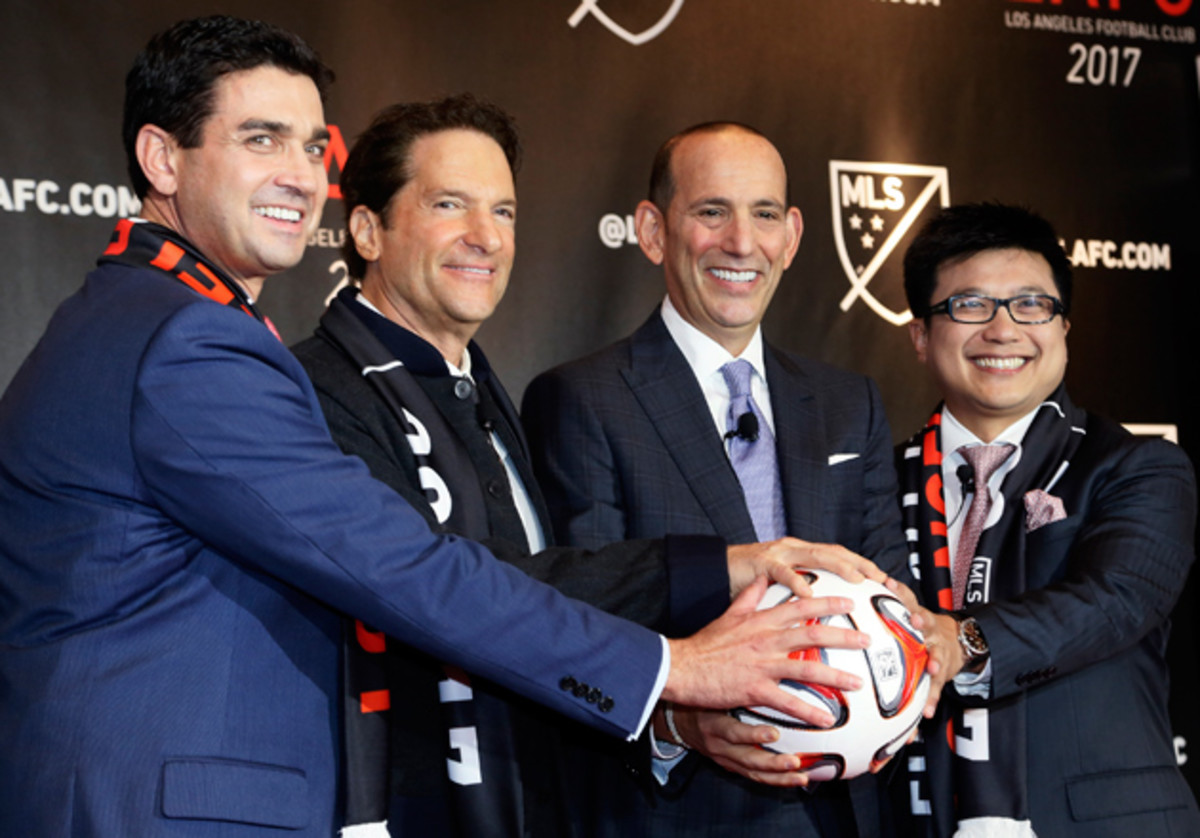
SI: When a new ownership group like LAFC pays a $110 million expansion fee to the league, I assume they don’t just write a $110 million check to MLS and hand it to you. Over how many years does that money come in, and how is it distributed once it does come in?
Garber: The LAFC owners wrote a $110 million check upon closing. And that money is distributed to the MLS owners in payment for the dilution of their interest in MLS. They now have a partner that will share in revenues and will help them basically work together to grow the league.
SI: Interesting. Was it at least one of those oversized checks you see on TV shows?
Garber: (laughs) By the way, it’s the only time an ownership group has come in and paid its expansion fee in full [at the start]. The other ones have been spread over time.
SI: Why was LAFC different?
Garber: I just think we’re at the point now that’s something that makes more sense for our ownership group.
SI: And the $110 million check cleared?
Garber: (laughs) It cleared.
SI: Speaking of expansion, it has now been 664 days since the press conference announcing David Beckham was exercising his option to own an MLS team in Miami. He’s got Tim Leiweke on board now, which is a good sign, but they still don’t have a stadium deal, and now they’re talking again about alternative sites. Sacramento’s MLS stadium renderings come out today. At what point would Sacramento or San Antonio leapfrog Miami for spot No. 24?
Sacramento Republic unveils renderings for new soccer stadium
Garber: We remain focused on trying to close a deal in Miami with David Beckham and his partners. And before we can do that they need to finalize a stadium plan. They continue to make progress and are now looking at a new site. So the question for me is not does Sacramento come in before Miami? It’s more: How do we get Sacramento into MLS? And I have enormous respect for the Republic and their owners and everything they’ve done and the municipal support they have.
And I hope we can work together to find a way that they are in MLS.
SI: What’s the current timeline for which years you expect your next four expansion teams to start playing in MLS?
Garber: Atlanta in 2017. LAFC in 2018. And we have not yet determined a start date for Minnesota, and we have not yet finalized a deal in Miami. What we do have is a target that I set out years ago that we will [have] 24 teams by 2020.
SI: How soon could we expect team No. 25 to join the league?
Garber: I don’t know the answer to that. But there certainly is more momentum for expansion than ever before. And there are markets now that seem to come up that weren’t even part of our thinking a year or two ago. I just had a great visit in Detroit, and we’ve been spending some time looking at that market. We’ve been having discussions with people in San Diego, discussions with people in St. Louis, and of course we remain really excited about what’s going on in Sacramento.
SI: 2015 was a big year for women’s soccer. You now have three MLS teams owning teams in the NWSL. How many more MLS teams can we expect to own women’s teams?
Garber: I’d like to see every MLS team own a women’s team at some point. I’ve come around from my thinking in the past and believe that our owners are so committed to the sport of soccer in their local communities and have made such deep investments in infrastructure and stadiums and training grounds and administrators and technical folks that there’s no reason why in the right market we couldn’t end up with many more MLS team owners owning women’s professional teams. How that plays out and over what period of time is still a real unknown. But I’m a believer in the women’s game and I’m also a believer that MLS needs to continue its role of developing the game at all levels. And now might be the right time to expend some efforts figuring out what we can do with the women’s game.
I think the recipe for success in MLS is a committed owner, a market that loves and is engaged in the game and the right facilities. And if we get that right as we have in almost every market, we ought to be able to provide soccer offerings at the youth level, with the women’s game and with the men’s game in ways that benefit everybody that’s associated with the sport in the U.S. and Canada.
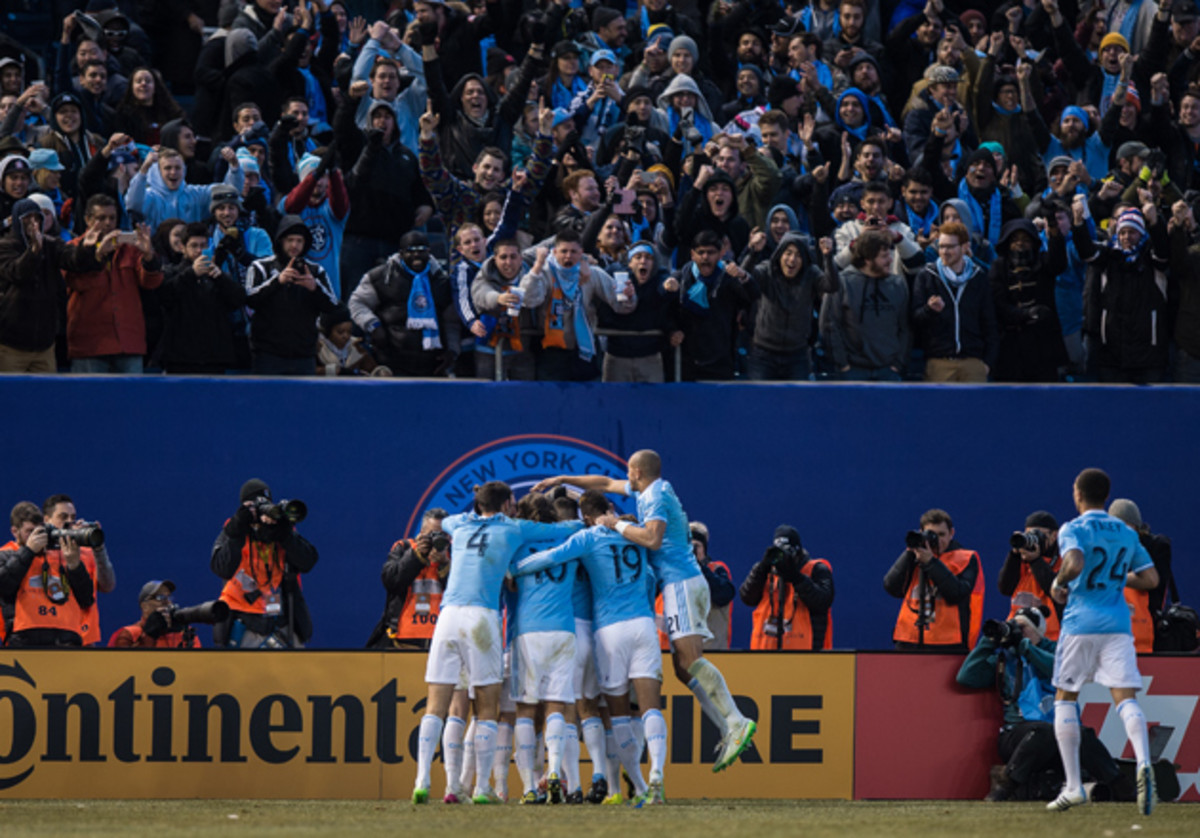
SI: You pushed hard for a second MLS team in the New York City area. NYCFC did well attendance-wise in its first year, and there’s buzz in this city for that team. On the field, it struggled and fired its coach, and there hasn’t been any stadium progress. What’s your view on NYCFC’s successes and struggles?
Garber: The real measure of success is: Is your team relevant in the community? That’s the most important thing any pro sports team needs to achieve. And we’ve achieved that with NYCFC. They’ve captured their own fanbase that loves coming up to Yankee Stadium on the subway and are averaging 29,000 fans, which is third-largest in MLS in their first year. That’s fantastic. We all know that it’s difficult to have quick success in MLS today. That’s the view of players and also our owners who’ve been around the block.
From Patrick Vieira's perspective, NYCFC a calculated coaching step
You can’t just come in and wave a magic wand and win MLS Cup. If you could do that, it would have all of us questioning the competitive credibility of our league. So I don’t look at their inability to make the playoffs as a failure at all. Frankly, I think they put together a pretty good model. They’ve just brought in a very promising coach [Patrick Vieira], and I’m excited about seeing what they can do next year. I think it’s been a great inaugural season for them.
On the stadium front, stadium projects are difficult. We know that because we’ve just completed our 15th. We’ll soon have 20. Every single one of them is hard. It took us 10 years to get Avaya Stadium done. So it doesn’t frustrate me that we don’t have an immediate plan for NYCFC. What I’m encouraged by is how much time they’re spending working on it. They are fully committed to it. They wouldn’t have had a team if they didn’t have that commitment. And we’ll continue to work hard with them and the city of New York and landowners to find the right site. I’ll tell you that the Man City folks are very passionate and committed MLS owners. I speak to them all the time. Ferran Soriano is a very influential member of our board in a very short period of time. They’re terrific.
Earlier today I was meeting with Oliver Mintzlaff [the Red Bull global head of soccer], and we were joking about their previous president’s [Jérôme de Bontin’s] concerns about NYCFC coming in, and [the Red Bulls] had their best year in their history: financially, and on and off the field. So this idea of creating rivalries to break through the clutter and get people to pay more attention to MLS is the right idea. You have to execute it properly, and I think so far the execution in year one was really good.
SI: And you’re O.K. with NYCFC being in Yankee Stadium for five more years maybe?
Garber: I don’t know how many years they will be in Yankee Stadium. As a temporary solution it’s fantastic. And nearly 30,000 fans a game think it’s pretty cool.
SI: There have been reports of an ownership change in Houston. Is AEG selling its share of the Dynamo?
Garber: Phil Anschutz made a commitment to his partners in 2001 that he would divest in all but one team as quickly as he could. The last piece of a team [other than the LA Galaxy] that he owns is Houston, and there’s no secret he has been talking about getting somebody to come in and purchase his 50% interest. And he’s committed to it, and we’re committed to helping him get that done. No news to announce as we’re sitting here today.
SI: February has an unprecedented situation happening in CONCACAF Champions League. You have four MLS teams going up against four Mexican teams in the four CCL elimination series. It’s not the best time of the year for MLS to have these games, but whether you like it or not, a lot of people will view this as a referendum on MLS vs. Liga MX. Is that fair?
Garber: If people want to view the upcoming Champions League games as a referendum on MLS and not look at it in the context of we’re playing in our preseason and they’re playing in the core of their season, it would be unfair. But it is what it is. And we need to do as well as we can because it’s really important that we stand toe to toe against the Mexican league similar to the way we can on the national team side.
After setting global target, it's time for Klinsmann to reclaim CONCACAF
That rivalry between the U.S. and Mexico on the national team side has really elevated the sport in our country, and I think if we could have a similar rivalry against the top Liga MX teams it would the same benefits for the professional game. I wish there were ways we could address the issue, and maybe with CONCACAF going through it’s changes and having new leadership we’ll be able to do so. But for now we’ve just got to do everything we can to try and win those games.
SI: Is the league going to do more than it has before to help CCL teams?
Garber: We’re looking for ways we could provide the MLS teams in the Champions League with as much value as we can without violating our rules and creating issues for the league competition, which without a doubt is the No. 1 priority.
SI: Targeted allocation money was considered a success in its first year in 2015, and it allowed more stars to come into the league. I’ve reported it’s likely that MLS owners will vote this week to increase the amount of TAM beyond the original $500,000 over five years per team. What are the chances of that happening?
Garber: There’s no doubt that the TAM program was successful. And it speaks to our approach that we need to be very strategic about how we improve our rosters at the top with our designated players, at the bottom with our development programs and in the middle through player development and also through the TAM program. I think that three-legged stool is going to be a big part of our thinking going forward. There is momentum to spend more money in TAM. We will spend some time talking about it at our upcoming board meeting [this Saturday], and we’ll see where it comes out.
SI: One of the biggest stories of the year was the new collective bargaining agreement. A lot of people, including me, were surprised that the MLS salary budget would be just $4.2 million per team in 2019. We already know how much national TV money is coming into the league through 2022, around $3 million per team per year. If you want to reach your stated goal of being one of the world’s top leagues by 2022, how is it possible to do that with a salary budget that low and the TV income already known?
Garber: You know, it surprises me that people don’t accept at this point that the salary budget is only one component of what we spend on players. So there’s designated player spending that’s outside the budget, there’s TAM spending that’s outside the budget, there’s allocation money that’s outside the budget, there’s youth development spending that’s outside the budget. We’re spending infinitely more than the $4 million a club across all of our teams, even those that aren’t spending a lot on designated players. So the total amount is what we’re looking at. Because we’re looking at spending our money in ways that will improve the quality of play and utilizing the revenues we have in ways that will move the needle and have a league that’s more competitive, more attractive and has enough compelling interest to fans that they’ll want to follow us socially, watch us on television and go to our games.
SI: How much money are we talking about being spent per team then?
Garber: Several times higher.
SI: And you think that’s enough to become one of the world’s top leagues by 2022?
Garber: Yes. We have time between now and 2022.
SI: The U.S. men’s national team had a pretty good World Cup in 2014, and MLS rightly got some accolades for that. The USMNT had a bad year in 2015. Lots of its players are in MLS. Is any of that bad year on MLS?
Garber: We will never run away from one of our core goals, which is to drive the growth of the sport in the U.S. and Canada so that we both can be powerful soccer nations. In order to really be influential in the world of global soccer, you need to have successful national teams. We spend a great deal of time with our federation working in partnership with them and their technical people to get better, and if we do get better we feel good about that. If we don’t achieve, we feel bad about it.
USMNT must regain its identity in 2016 as disappointing year ends
So whether it’s three players or four players or six players or whether we think we should have more players on the team than we do in one particular game, that’s really not the issue. The issue is are we getting better? And is MLS doing its part to improve the sport at all levels, whether it’s at the youth level or at the senior national team level? Do I feel badly when we don’t qualify for FIFA youth tournaments? I feel terrible about it, and I take some responsibility for it.
And I wish I had the ability to have even a greater role in influencing what happens in those programs. But we do what we can in partnership with the federation to try to improve every year.
SI: Is Jurgen Klinsmann the right coach to lead the U.S. national team forward?
Garber: It’s not my call. It’s Sunil Gulati’s call. I have learned to accept that while we’re going to be involved deeply in the sport at the foundational levels, it’s not appropriate for us to be making decisions on who the coach is of the senior national team or the technical director or who their youth coaches are. We, no different from anyone else, will feel really good when they make good decisions and have success, and we’ll feel really bad like everybody else does when they don’t have success. But all I can really do as the commissioner of this league is provide as much support as I can for Sunil Gulati and Dan Flynn and Jay Berhalter and let them know we’re here to do what we can to make our national teams better.
SI: Does it bother you that MLS Best XI Americans like Ethan Finlay, Benny Feilhaber, Dax McCarty and Luis Robles haven’t been a part of the USMNT picture?
Garber: Yes. It does. Deeply. I think it’s unfair and unwarranted.
SI: Wednesday is the five-year anniversary of the FIFA vote to give World Cup 2022 to Qatar ahead of the United States. You were there in Zurich, I was there. I have two questions about it for you. First, now that five years have passed, can you be candid about what you remember experiencing and thinking that day? Did you think: This World Cup was bought?
Garber: I was in a meeting with President Clinton and a group of other members of our board with some FIFA folks prior to the actual [vote]. And we were not celebrating, but we felt pretty good that the World Cup was coming to the United States. And when I was in the auditorium with others on our committee, we were talking to each other about where we would stand when the World Cup was announced that it was coming to our country. So I am as shocked and disappointed today as I was five years ago. I can’t comment on why it happened or how it happened. I’ve moved on from that, as have most others. And as somebody that’s always fought adversity and have been doing that for 16 years as MLS commissioner, we licked our wounds and will figure out what to do to get the World Cup back in the U.S. as quickly as we can.
SI: Second question: Do you think World Cup ’22 will actually take place in Qatar?
Garber: I do. Because I believe a decision was made, and plans have been put into place. And money has been invested and people have worked hard on stadiums. Some making sacrifices greater than others. So I don’t believe it’s going to be anywhere other than Qatar. My own personal opinion, by the way.
SI: There’s a lot of Qatari investment in soccer everywhere at this point. Is there a chance that Qatar Sports Investments may become involved with Beckham’s MLS ownership group in Miami?
Garber: I can’t comment on that.
SI: Another big story this year was the FIFA arrests on May 27, the U.S. Department of Justice indictment and Sepp Blatter announcing his resignation as FIFA president. One of the most prominent figures involved who’s already pled guilty is American Chuck Blazer. I feel like I should have done much more as a journalist to investigate Blazer while he was operating in office. Do you have any similar feelings based on what you knew about Chuck or wondered about him?
Garber: It’s really not the league’s role to investigate somebody that might have been involved in bad behavior. There’s no doubt that Chuck was a larger-than-life figure, but in all my experiences with him I attributed that to him being involved as a day-trader and just being a character of epic proportions. One thing I’ve learned as the brother of a prosecutor who now works with the NYPD is: Bad people who are criminals do a really good job of covering up their illegal behavior. And they can cover it from their partners, from their spouses, from their family, as I believe Chuck did very effectively here.
SI: What was your reaction on May 27 when those FIFA arrests were made in Zurich? Were you as stunned as the rest of us were?
Garber: I was stunned that the arrests were made. I wasn’t really all that surprised [about the allegations].
SI: The U.S. has yet to produce a male soccer global superstar. Why not? And how close are we to doing so?
Garber: I think we’re on the cusp and have gotten close in the past with players like Landon Donovan and Michael Bradley and Claudio Reyna and Clint Dempsey and Tab Ramos. I sort of go into every season thinking that this next great young player might be The One. And maybe Gyasi Zardes is that player. And I’m hopeful that he might be. One thing that I believe is that we need to get more focused on what it is that we’re doing to develop players, starting at the earliest age categories through their early teens and as they begin their professional careers.
Clearly what we’re doing has not worked. With all the people that played, with the league’s at least 10 years of being involved in development, you’d like to think we would have been able to have at least one or two players that are performing at a level of at least where Chicharito is—a guy that’s performing at the highest level of the Bundesliga. It doesn’t mean that we’ll have a Lionel Messi or a Neymar or a Cristiano Ronaldo anytime soon, but we ought to have several players who are among the best in the world in the top 20 or 25. And I think we need to get focused on that as a real goal and get together with our federation, get together with our youth clubs, get together with everybody who is involved in this sport and just start putting the excuses aside and all of the special interests aside and get focused on that goal. I’m very serious about that.
SI: MLS added a lot of big names in 2015: Giovinco, Villa, Lampard, Pirlo, Drogba, Kaká, Dos Santos, Gerrard, Altidore. How many big names can we expect in 2016?
Garber: I don’t know the answer to that. It’s too early to speculate. Certainly nobody was thinking sitting here today a year ago that Sebastian Giovinco would be signed by Toronto or that NYCFC would be able to bring in Pirlo or that LA would be able to get Gerrard or Giovani Dos Santos. Our teams are going to work hard on ensuring that they are signing the best possible players in all three categories. It’s not just about the big names. It’s about those players who could make our rosters better at the bottom, middle and top of our rosters.
It’s interesting: There was a time when the league was driving this process, and that’s not the case anymore. There was a time many years ago when Didier Drogba’s agent would reach out to the league and the discussion would start out at the league level, and then ultimately we would try to figure out what clubs were interested in a player with Didier’s experience. While those negotiations are still held at the league level, all these relationships have been developed by our clubs, who in addition to bringing in and developing great coaches are now becoming far more expert in the technical side and having scouting programs and having a wide variety of outreach efforts so that our league and our clubs are mentioned when big players around the world are thinking of what their next move in their career is at all age levels.
People talk about the ages of the big names that came in. The average age of the players that were signed this summer was 27 years old. People talk less about that because they talk about the age of the biggest-name players who came in.
